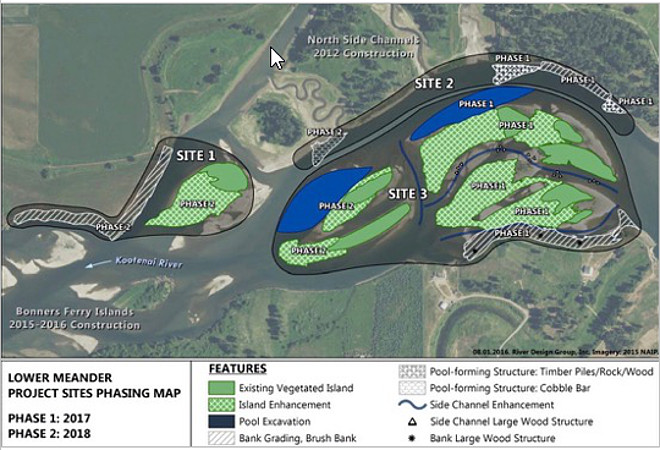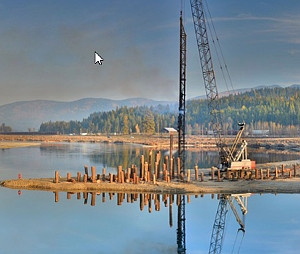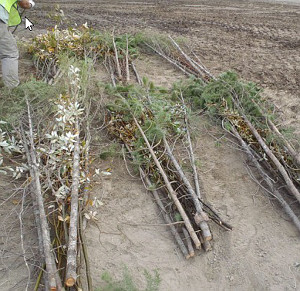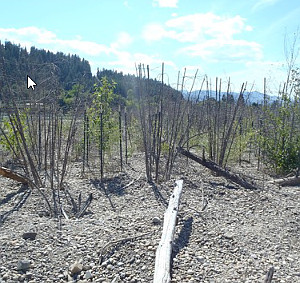|
Building great habitat for our unique Kootenai
River fish |
|
September 1, 2017 |
 |
By Susan Ireland
Fish and Wildlife Department Director
Kootenai Tribe of Idaho
The Kootenai Tribe is building a project to
increase and improve habitat for Kootenai River
white sturgeon, burbot and other native fish.
Construction of the project, which is upstream
from Bonners Ferry between river miles 153.5 and
155, began in late August.
The Lower Meander Project is part of the Tribe’s
Kootenai River Habitat Restoration Program and
will be the tenth project to be built under this
program since 2011.
The project will include excavation of two
pools, construction of three large spurs,
enhancement of six river islands, bank
restoration, installation of wood structures,
and revegetation.
The two excavated pools will expand a string of
pools created through the shallow braided reach
of the river. These pools provide places for
fish to rest and feed as they move up and down
the river, and also a place for sturgeon and
burbot to stage when they are getting ready to
spawn.
 |
| Example of
construction of a pool-forming spur. |
To help maintain the excavated pools, three
large pool-forming spurs will be built. These
spurs, which are shaped like a fish fin and jut
into the river at angle from the bank, will also
protect the streambanks from erosion and create
eddies where fish congregate.
Materials excavated from the two pools will be
used to build up the elevation of six existing
islands. This will provide floodplain surfaces
that can support native vegetation at a range of
managed flows. Vegetated floodplains help
contribute nutrients, plant debris and insects
that improve the food web to help feed fish and
other organisms.
In the channel that runs between the islands, a
number of large wood structures will be built to
create scour pools used by fish.
A length of streambank will also be graded to
help minimize erosion and create more floodplain
surfaces. Old car bodies and other debris will
be removed and the area will be planted with
native plants and seeds. The new plants on the
islands and streambanks will be protected from
deer, beaver, geese and other wildlife using a
combination of fencing, individual plant
enclosures and brush bundles.
 |
| Brush
bundles prior to installation. The brush
bundles are not intended to grow; their
purpose is to shield live plants from
deer and other wildlife. |
The brush bundles are a technique that was used
successfully on a constructed island across from
the Kootenai River Inn in 2015. Conifer branches
and other dead plant materials are placed in
protective bundles around the newly planted live
trees and shrubs.
After a while the conifer's needles and other
materials turn brown, but the protected plants
inside the bundle are alive and growing. You can
still see some of these brown bundles on the
islands across from the Kootenai River Inn. The
plants inside are growing bigger and stronger
with every month and will eventually grow
through their brown protective bundles.
The habitat restoration program compliments the
Kootenai Tribe’s conservation aquaculture
program, which annually releases Kootenai River
white sturgeon and burbot into the river.
The habitat improvements will help these
hatchery-reared fish to thrive in the river and
reproduce on their own.
Construction of the Lower Meander Project will
occur in the summer and fall of 2017 and 2018.
Funding for the habitat program comes from the
Bonneville Power Administration through the
Northwest Power and Conservation Council’s Fish
and Wildlife Program.
 |
| Plants
growing between brush and inside browse
protector cages on island in front of
Kootenai River Inn, July 2017. |
The Northwest Power Act of 1984 required that
funding to mitigate for harm caused to fish,
wildlife and their habitats by construction and
operation of the federal Columbia River
hydropower system be built into regional power
rates. Electricity in the Pacific Northwest is
among the least expensive electricity in the
U.S. due to the Columbia River hydropower
system, including Libby Dam.
The Bonneville Power Administration provides
approximately $250 million annually in
mitigation funding. This money is distributed
throughout the entire Columbia River basin
through a competitive process managed by the
Northwest Power and Conservation Council, which
incorporates science and policy reviews of all
proposals.
The Kootenai Tribe competed for and won funding
for the Kootenai River Habitat Restoration
Program through this process.
Construction updates and other information about
this project and the Kootenai River Habitat
Restoration Program will be posted on the
Tribe’s website at
www.restoringthekootenai.org. |
|
Questions or comments about this
article?
Click here to e-mail! |
|
|
|
|

